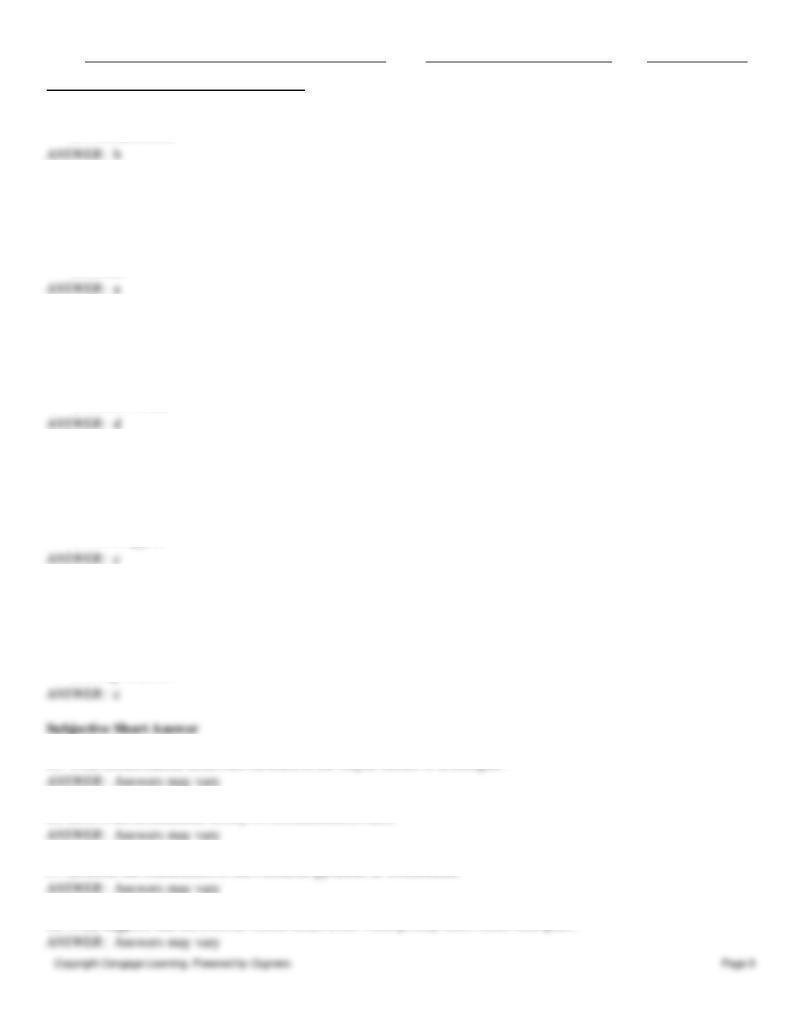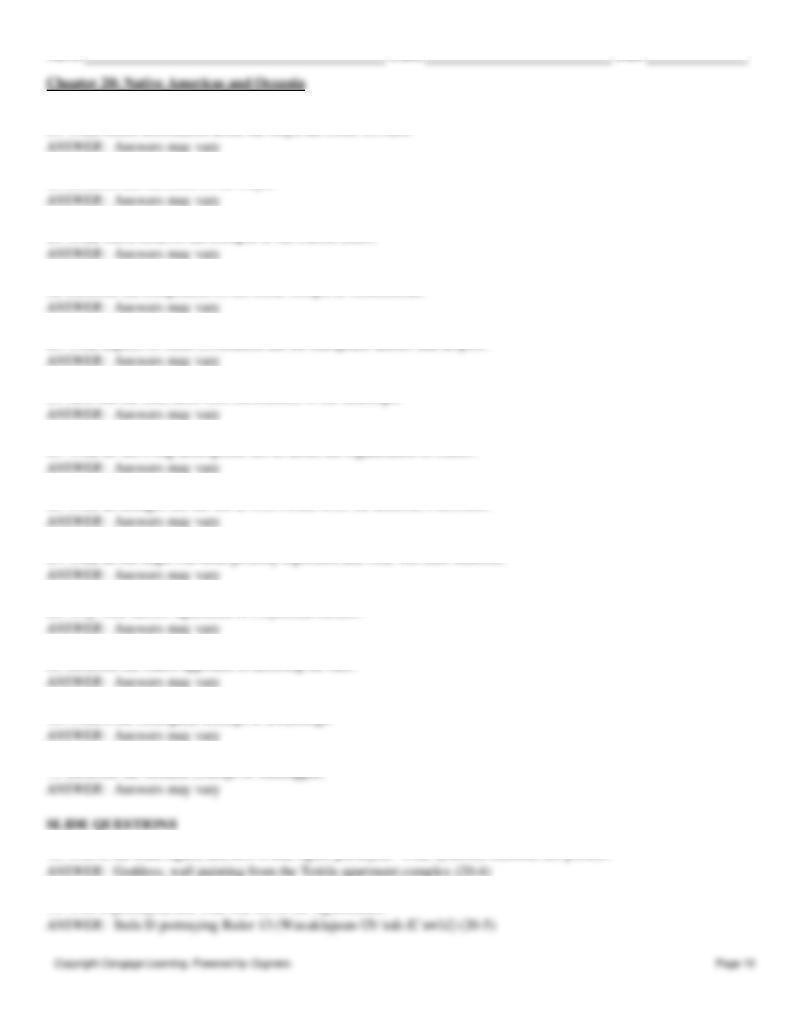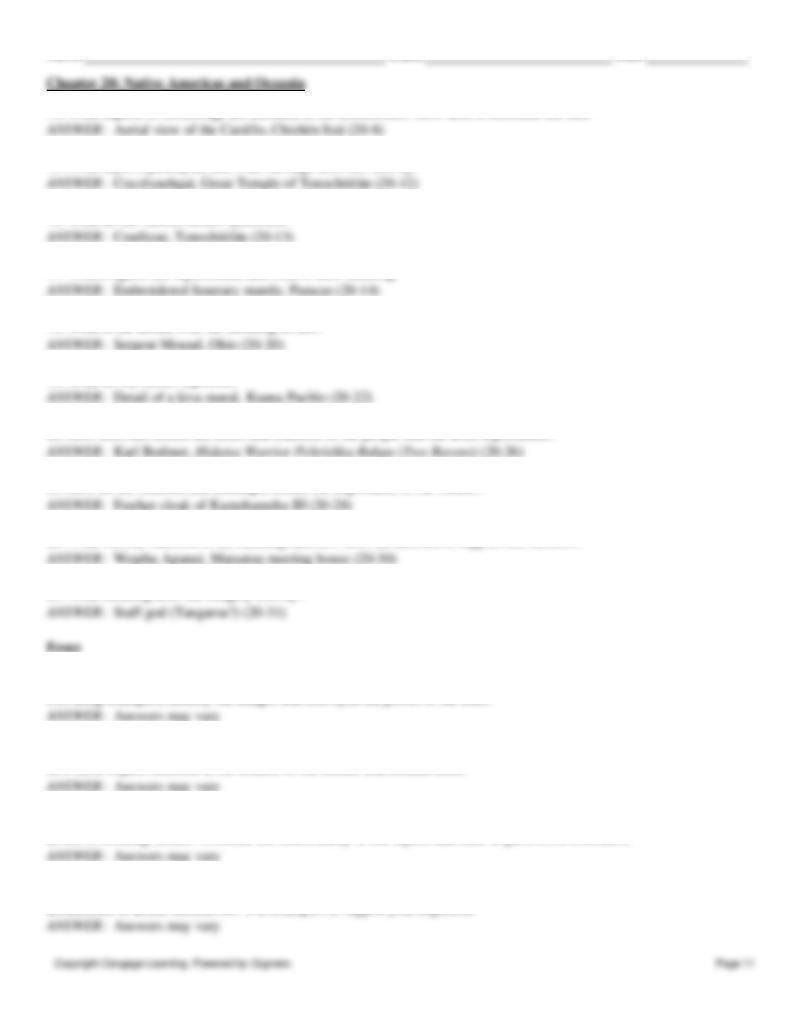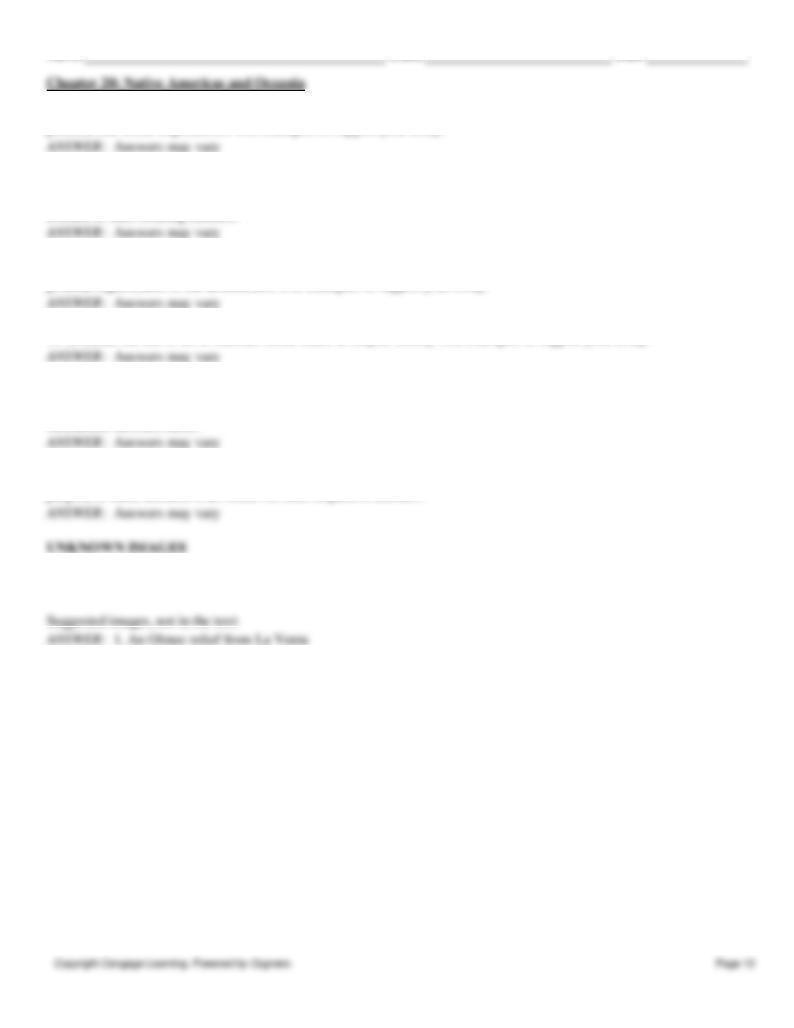
Name:
Class:
Date:
Chapter 20: Native Americas and Oceania
Multiple Choice
1. The _____ were the most renowned of the indigenous people of the Western hemisphere before 1300.
a.
Maya
b.
ancestral Puebloans
c.
Nascas
d.
Olmecs
2. What term is used for the present-day region of Mexico, Guatemala, Belize, Honduras, and the Pacific coast of El
Salvador?
a.
Oceania
b.
Mesoamerica
c.
Preclassic
d.
Andean
3. The site where Olmec people gathered for religious rituals was _____.
a.
Tenochtitláan
b.
Chichén Itzá
c.
La Venta
d.
Bonampak
4. The pyramid form found at La Venta may have been chosen because of its visual association with _____ held sacred by
the people.
a.
the king’s headdress
b.
the sun
c.
Egyptian architecture
d.
a mountain
5. The center of the Preclassic city at Teotihuacán is _____.
a.
the Pyramid of the Sun
b.
a colossal Olmec head
c.
a stele with a ruler portrait
d.
a ball court
6. The ______ were the only ancient American society to create a systematic written history.
a.
Olmec peoples
b.
Maya
c.
ancestral Puebloans
d.
Nascas

Name:
Class:
Date:
Chapter 20: Native Americas and Oceania
7. _____ was one of the first Mayan sites excavated.
a.
Tenochtitlán
b.
La Venta
c.
Copán
d.
Chichén Itzá
8. The Maya erected stelae with _____ in the city of Copán’s great plaza.
a.
records of their battles
b.
an image of the hummingbird god
c.
sacrificed enemies
d.
portraits of their rulers
9. _____ were common features of Mesoamerican cities.
a.
Ball courts
b.
Latrines
c.
Earthen mounds
d.
Canals
10. _____ celebrates the important role of elite women.
a.
Goddess, wall painting from the Tetitla apartment complex,
b.
Shield Jaguar and Lady Xoc
c.
Stele D portraying Ruler 13
d.
Coyolzauhqui
11. _____ are representations of fallen warriors that held receptacles for sacrificial offerings.
a.
Moches
b.
Paracas
c.
Chacmool
d.
Katsinas
12. The arrival of the _____ in central Mexico coincided with the fall of the Classic civilizations.
a.
Hopi
b.
Olmecs
c.
Paracas
d.
Toltec

Name:
Class:
Date:
13. The Toltec colossal _____ at Tula were meant to ward off hostile forces.
a.
atlantids
b.
colossal heads
c.
chacmool
d.
pyramids
14. The _____ engaged in human sacrifice on a greater scale than any other Mesoamerican people.
a.
Toltecs
b.
Olmecs
c.
Aztecs
d.
Nascas
15. How was the city of Tenochtitlán laid out?
a.
A spiral
b.
Temples aligned with the sun and moon
c.
Around the Avenue of the Dead
d.
A grid divided into quarters
16. _____ describes the practice of the Aztecs and other Mesoamerican peoples of nesting earlier walls within later
structures.
a.
Superimposition
b.
Recycling
c.
Kivas
d.
Pueblo
17. The Aztec image of Coyolxauhqui from the Great Temple portrays _____.
a.
a ruler’s mistress
b.
the disembodied body of the moon goddess
c.
a serpent
d.
the hummingbird god
18. The _____ wrapped their dead in layers of fabric with embroidered designs.
a.
Olmecs
b.
Toltecs
c.
Paracas
d.
Nasca
19. The _____ created immense earth drawings.

Name:
Class:
Date:
Chapter 20: Native Americas and Oceania
a.
Maya
b.
Inka
c.
Nasca
d.
Aztecs
20. Nasca earth drawings seem to be related to _____.
a.
the movement of the sun
b.
their various deities
c.
planting crops
d.
water supply and irrigation
21. At the time of the Spanish conquest, the _____ had the largest population in the world.
a.
Inka
b.
Nasca
c.
Moche
d.
Adena
22. The Inka used _____ to maintain highly accurate records of their inventories and possessions.
a.
kiva
b.
khipu
c.
chacmool
d.
atlantids
23. The Woodland Adena culture of Ohio buried their elite with _____.
a.
shields
b.
funerary cloths
c.
pipes
d.
beads
24. Miisissipian effigy mounds usually housed _____.
a.
gold
b.
weapons
c.
pottery
d.
burials
25. The _____ is an important motif in Mississippian art because of its association with earth and fertility of crops.
a.
serpent
b.
rain god

Name:
Class:
Date:
Chapter 20: Native Americas and Oceania
c.
hummingbird
d.
moon god
26. The _____ were the dominant culture of the American southwest before the Europeans.
a.
Mississippians
b.
Ancestral Puebloans
c.
Andeans
d.
Hopi
27. ______ were the spiritual centers of ritual and civic life for the ancestral Puebloans.
a.
Forests
b.
effigy mounds
c.
Kivas
d.
Palaces
28. The Northwest tribe _____ wore masks in healing rituals and performances.
a.
Andeans
b.
Kuaua Pueblos
c.
Hopi Katsinas
d.
Kwakwaka’wakw
29. _____ are the colossal sculptures found Easter Island in Polynesia.
a.
Moai
b.
Kwakwaka’wakw
c.
Dreamings
d.
Katsina
30. _____ one of the most pervasive art forms found throughout Oceania.
a.
Masks are
b.
Body decoration is
c.
Earth drawings are
d.
Bark painting is
31. Polynesians developed the art of _____ more fully than any other Oceanic peoples.
a.
bark paintings
b.
cloaks
c.
tattoo
d.
atlantids

Name:
Class:
Date:
Chapter 20: Native Americas and Oceania
32. Reflecting their nomadic lifestyle, a popular Aboriginal art form _____.
a.
is pukao
b.
is mataatua
c.
are cloaks
d.
are bark paintings
33. _____ are common subjects of Aboriginal art.
a.
Dreamings
b.
Deities
c.
Landscapes
d.
Animals
34. _____ are created for the Oceanic malanggan festival.
a.
Feather cloaks
b.
Tatanua masks
c.
Katsinas
d.
Rarotonga
35. Which of the following has been proposed as the identity of the giant Olmec heads?
a.
Priests of the Feathered-Serpent
b.
Deities
c.
Maya overlords
d.
Tulers
36. When can humans join the Katsina world?
a.
When males attain their majority
b.
When females marry
c.
When either a male or a female makes a pilgrimage to the Sangre de Cristo mountains
d.
After death
37. Murals found in the prehistoric pueblos of the Southwest most often depicted which of the following?
a.
Warriors and conquest
b.
Royal court ceremonies
c.
Coming-of-age ceremonies
d.
Spirits associated with agricultural fertility

Name:
Class:
Date:
38. Why did most Plains people focus their artistic attention on clothing and other portable objects?
a.
Because they wanted to sell their goods to travelers
b.
Because they believed monumental sculpture was a waste of resources
c.
Because they were nomadic
d.
because they wanted to wear symbols of their religious beliefs at all times
39. What is remarkable about the stones used in the construction of the Temple of the Sun, Cuzco, Peru?
a.
They are the first instance of the use of mortar to hold the blocks together.
b.
They were brought in from hundreds of miles away for reasons unknown.
c.
There is no mortar used yet they are a perfect fit.
d.
They are each marked with a symbol of an Incan deity.
40. (Figure 20-5)
a.
Tikal
b.
Copán
c.
Teotihuacán
d.
Tula
41. (Figure 20-10)
a.
Chichén Itzá
b.
Copán
c.
Teotihuacán
d.
Tula
42. (Figure 20-8)
a.
Tula
b.
Copán
c.
Teotihuacán
d.
Chichén Itzá
43. (Figure 20-14)
a.
Chile
b.
Bolivia
c.
Peru
d.
Ecuador
44. (Figure 20-15)

Name:
Class:
Date:
Chapter 20: Native Americas and Oceania
a.
Moche
b.
Chavín
c.
Nasca
d.
Paracas
45. (Figure 20-26)
a.
Hernan Cortez
b.
Maria Montoya Martinez
c.
Karl Bodmer
d.
Charles V
46. (Figure 20-11)
a.
Golden Enclosure, Cuzco
b.
Coricancha, Cuzco
c.
Tula, Mexico
d.
Great Temple, Mexico
47. (Figure 20-21)
a.
Ancestral Puebloan
b.
Inka
c.
Olmec
d.
Aztec
48. (Figure 20-23)
a.
Aztec
b.
Navajo
c.
Olmec
d.
Hopi
49. (Figure 20-24)
a.
Bill Reid
b.
Doug Kranmer
c.
Otto Pentewa
d.
María Montoya Martínez
50. (Figure 20-13)
a.
Coyolxauhqui
b.
Coatlicue

Name:
Class:
Date:
Chapter 20: Native Americas and Oceania
c.
Huitzilopochtli
d.
Mictlantecuhtli
51. (Figure 20-12)
a.
Aztec
b.
Mixtec
c.
Inka
d.
Olmec
52. (Figure 20-17)
a.
Tenochtitlán
b.
Cuzco
c.
Tikal
d.
Machu Picchu
53. (Figure 20-23)
a.
Aztec
b.
Moche
c.
Southwest
d.
Mississippian
54. (Figure 20-30)
a.
Bill Reid
b.
Karl Bodmer
c.
Wepiha Apanui
d.
Doug Kranmer
55. What circumstantial details are included in the Mayan murals of Bonampak?
56. How is the architectural history of Mesoamerica divided?
57. Describe the construction of the Preclassic pyramids at Teotihuacán.
58. What suggests that the colossal Olmec heads at La Venta portray rulers rather than gods?

Name:
Class:
Date:
59. What recent information about the Maya has come forward?
60. Describe the ball court of the Maya.
61. What was a result of the collapse of the Classic cities?
62. Describe the components of the Great Temple at Tenochtitlán.
63. What aspects of Aztec civilization did the Europeans admire and despise?
64. How did the Inka tailor their architecture to the landscape?
65. What do surviving descriptions tell us about the organization of Cuzco?
66. What advantages did the site at Cliff Palace offer the ancestral Puebloans?
67. What do the Rapa Nui moai possibly represent, and what was their function?
68. Why were tattoos significant in Polynesian culture?
69. Describe the Maori approach to tattooing the face.
70. What is the Aboriginal concept of Dreamings?
71. Describe the Oceanic concept of Malanggan.
72. Who is the main figure, and how is that figure portrayed? What symbolic elements are present?
73. Who is portrayed, and what was his or her significance?

Name:
Class:
Date:
74. What aspects of cosmology are included in the architecture? How does it reference the sun?
75. What myth is portrayed, and what message does this convey?
76. What do the various motifs symbolize?
77. Which figures are represented, and what is their meaning?
78. What is the debate over the meaning of this?
79. What do the motifs represent?
80. How does this reflect the tastes and tradition of the people that the artist represented?
81. How do the material and technique reflect the importance of the wearer?
82. What was the function of the building, and how does the decoration support this function?
83. What meaning does the imagery convey?
84. The rulers of these ancient civilizations asserted themselves through the monuments that they built and their images.
Providing examples, identify the images that conveyed the power of the ruler.
85. Several of the ancient cultures created monuments and images in honor of their deities. Providing examples, describe
how these objects function in the context of the culture that created them.
86. Contrast Coatlicue with the katsina of the Hopi. What visual elements help define each work? How does each work
define its creating culture? Consider the functionality of the objects and their respective environments.
87. Contrast the empires of the Aztecs and the Inka. Consider the purpose and function of each. How did they use art and
architecture to define themselves? Use examples to support your argument.

Name:
Class:
Date:
88. Evaluate the development of Aztec art forms. How did the Aztec use their art forms to define them? Consider the
political and social implications. Use examples to support your essay.
89. Compare and contrast the Olmec colossal head and the Mississippian Serpent Mound. How does each represent its
respective area? What visual elements are used to define the creating cultures? How do they each express visually the
essence of their creating cultures?
90. Evaluate monumental architecture and the role it played in Mesoamerican cultures. Include the religious as well as the
political significance of the architecture. Use examples to support your essay.
91. Evaluate the use of art to indicate social status in Mayan society. Use examples to support your essay.
92. Compare and contrast Tula and Chichén Itzá. How does each site respond to the needs of its respective groups? What
are their similarities, and how does each site function within its society? What outside influences might account for the
similarities between them?
93. Several of the cultures discussed in this chapter adopted distinctive art forms. Providing examples, describe the
purpose of these distinctive art forms for their respective cultures.
94. Attribute the images on the screen to a culture and give an approximate date. Give the reasons for your attributions,
using complete sentences and referring to specific works discussed in class.
2. The Aztec calendar stone
3. An Inka textile
4. Another pot from the Southwest, perhaps María Montoya Martínez
5. Another Mississippian work, perhaps a gorget